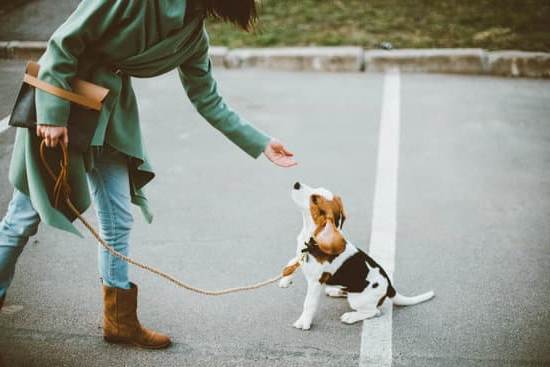Protective aggression in dogs can be a challenging behavior to address, but with the right training approach and understanding, it is possible to transform your dog into a well-behaved and balanced pet. In this introductory section, we will explore what protective aggression is and the causes behind it. We will also delve into why it is crucial to train a protective aggressive dog properly, as well as provide a brief overview of the training process discussed in this article.
Protective aggression refers to a type of behavior displayed by dogs when they feel the need to protect their territory, family members, or themselves. It often manifests as growling, barking, lunging, or even biting towards perceived threats.
Understanding the triggers for protective aggression is essential to effectively addressing this behavior. Whether due to fear, anxiety, past experiences, or other underlying factors – such as possessiveness or resource guarding – identifying the specific cause of your dog’s aggression will help you design an appropriate training plan.
Properly training a protective aggressive dog is of utmost importance for both their own safety and that of others. By addressing this behavior early on and equipping yourself with the knowledge and skills necessary for effective training, you can prevent situations from escalating and potentially causing harm.
Throughout this article, we will provide practical techniques and guidance on how to train your dog using positive reinforcement methods. So let’s dive into the different aspects involved in training a protective aggressive dog and empower both you and your furry companion on this journey towards behavioral transformation.
Assessing Your Dog’s Aggression Level
Protective aggression in dogs can manifest in various signs and behaviors, making it important for dog owners to accurately assess their dog’s aggression level. By understanding the specific characteristics of protective aggression, owners can better determine the appropriate training methods and seek professional guidance if necessary.
Signs and behaviors of protective aggression may include growling, barking, lunging, snarling, and even biting. These aggressive displays often occur when the dog perceives a threat or feels the need to protect its territory, owners, or resources. It is essential to differentiate between protective aggression and other types of aggression, such as fear-based or dominance-related aggression.
Early warning signs of protective aggression can provide valuable cues for dog owners to recognize potential triggers and manage their dog’s behavior effectively. These signs may include raised hackles, a stiff body posture, intense staring, and an overall heightened alertness. By being observant and understanding their dog’s body language and behavior patterns, owners can intervene before a situation escalates.
| Signs | Behaviors |
|---|---|
| Growling | Lunging |
| Barking | Snarling |
| Raised hackles (hair on the back) | Stiff body posture |
| Intense staring | Heightened alertness |
By being able to accurately assess their dog’s aggression level and identify protective aggression, owners can gain insights into their pet’s needs and tailor a training plan that addresses the specific behaviors involved. It is important to keep in mind that aggression issues are best addressed with professional guidance, especially when dealing with protective aggression. Seeking the assistance of a certified dog trainer or behavioral specialist can provide invaluable support throughout the training process.
Seeking Professional Help
When dealing with protective aggression in dogs, it is crucial to seek professional help from a certified dog trainer and behavioral specialist. These experts have the knowledge and experience necessary to guide you through the training process and ensure the safety of both you and your dog.
In this section, we will discuss the importance of professional guidance, how to find a certified dog trainer specializing in aggression issues, and what to look for in a behavioral specialist for your dog.
Importance of Professional Guidance
Training a protective aggressive dog can be challenging and potentially dangerous if not done correctly. A certified dog trainer specializing in aggression issues can provide you with the tools and techniques needed to manage your dog’s behavior effectively. They will have a deep understanding of protective aggression and will tailor their approach to suit your individual dog’s needs.
Finding a Certified Dog Trainer
When searching for a certified dog trainer, it is important to look for someone who has specific experience in dealing with aggression issues. Look for trainers who are certified by reputable organizations such as The Certification Council for Professional Dog Trainers (CCPDT) or The International Association of Animal Behavior Consultants (IAABC). These certifications ensure that the trainer adheres to ethical standards and has completed appropriate training.
Behavioral Specialist for Your Dog
In addition to finding a certified dog trainer, consider seeking guidance from a behavioral specialist who specializes in working with dogs with aggression problems. A behavioral specialist will conduct an initial assessment of your dog’s behavior, develop a comprehensive plan specifically tailored to address their protective aggression, and monitor their progress over time. Be sure to ask about their experience working with protective aggressive dogs before making a decision.
Remember that seeking professional help is not a sign of failure as an owner but rather an acknowledgment that you are committed to ensuring the well-being of yourself, your family members, and your furry friend. With the assistance of trained professionals, you can effectively address your dog’s protective aggression and work towards a happier and safer future together.
Creating a Safe Environment
Creating a safe environment is crucial when training a protective aggressive dog. By setting boundaries and limitations, you can provide structure and security for your dog, ultimately helping to manage their aggression. Here are some important steps to take:
- Establishing a designated space for your dog within your home: Providing your dog with their own designated space can give them a sense of security. This space should be comfortable, quiet, and free from potential triggers that may cause aggression. It can be a separate room or even just a specific area in your home where your dog feels safe.
- Implementing secure fencing and containment measures: It’s essential to have secure fencing around your property to prevent your dog from escaping and potentially causing harm to themselves or others. Additionally, consider using physical barriers such as baby gates or crates to limit access to certain areas of the house where there may be potential triggers present.
- Ensuring the safety of guests and family members: When dealing with protective aggression, it’s important to prioritize the safety of everyone involved. Inform visitors about your dog’s behavior and establish rules they should follow when interacting with your pet. Restrict unsupervised interactions between your dog and unfamiliar individuals until you are confident in their ability to remain calm.
| Aspect | Actions |
|---|---|
| Establishing Dog’s Space | Create a designated space within the home where the dog feels safe and comfortable. |
| Fencing and Containment | Ensure secure fencing around the property while using physical barriers like gates or crates indoors. |
| Safety of Guests and Family Members | Inform visitors about the dog’s behavior, establish rules for interactions, and restrict unsupervised contact with unfamiliar individuals. |
By creating a safe environment for your protective aggressive dog, you can minimize potential triggers and reduce the likelihood of their aggressive behavior. This, in turn, contributes to a more stable and controlled training process. Remember to always prioritize safety and consult with professionals if you have any concerns or questions throughout this journey.
Positive Reinforcement Training
The Power of Positive Reinforcement
Positive reinforcement training is widely recognized as one of the most effective methods for training dogs, including those with protective aggression. This approach involves rewarding your dog for exhibiting desired behaviors, reinforcing positive associations, and creating a strong bond between you and your pet. The use of punishment or aversive techniques is not recommended, as they can exacerbate aggression and damage the trust between you and your dog.
Introducing Clicker Training and Rewards-Based Techniques
Clicker training can be a valuable tool in shaping desirable behavior in a protective aggressive dog. With clicker training, you use a small handheld device that emits a distinct clicking sound to mark the exact moment your dog performs a desired behavior. This is followed immediately by providing a reward such as treats, praise, or play. The clicker serves as a communication tool to clearly indicate to your dog which behaviors are being reinforced.
Rewards-based techniques involve using positive reinforcement to reward your dog for responding correctly to commands or displaying calm behavior in potentially triggering situations. These rewards can include treats, verbal praise, toys, or any other forms of positive stimuli that motivate your dog. By consistently rewarding desirable behaviors, you are teaching your dog what is expected of them and motivating them to repeat those behaviors in the future.
Teaching Basic Obedience Commands and Commands Specific to Aggression Control
Training basic obedience commands such as sit, stay, down, come, and leave it are essential building blocks for shaping desirable behavior in any dog. These commands provide structure and enhance communication between you and your protective aggressive dog. They also help establish you as the pack leader and give your dog confidence in following your guidance.
In addition to basic obedience commands, it is important to teach specific commands that address aggression control. For example, teaching “quiet” or “enough” command can help redirect your dog’s focus and calm them down when they start displaying aggressive behavior. Teaching a “safe place” command can provide your dog with an alternative behavior to adopt in stressful situations, such as going to their designated spot or crate.
By employing positive reinforcement training techniques and teaching both basic obedience commands and commands specific to aggression control, you can effectively shape desirable behavior in your protective aggressive dog. Remember to be patient, consistent, and always reward good behavior, gradually building towards a transformed dog.
Controlled Socialization
Controlled socialization plays a crucial role in training a protective aggressive dog. It helps them gradually become comfortable and confident in various environments, as well as interact appropriately with other dogs. This section will provide insights into the importance of controlled socialization, techniques for exposing your dog to different stimuli, and tips for introducing your dog to other dogs.
Firstly, it is essential to understand why controlled socialization is important for a protective aggressive dog. Dogs with protective aggression often display fear or discomfort around unfamiliar people or situations. Controlled socialization allows them to explore new environments and experiences at their own pace, helping them build positive associations and reduce fear or anxiety responses. Additionally, gradual exposure to different stimuli and other dogs can teach the dog appropriate behaviors and improve their overall social skills.
To effectively introduce controlled socialization, start by exposing your dog to various stimuli in a controlled manner. This could include different sounds, sights, smells, and textures that may trigger their aggression. Begin with low-intensity stimuli that are less likely to provoke an aggressive response. For example, if loud noises trigger your dog’s aggression, start by playing recordings of these sounds at a low volume while rewarding your dog for remaining calm.
Introducing your protective aggressive dog to other dogs should also be done carefully and gradually. Start by allowing them to observe other dogs from a distance while providing positive reinforcement for calm behavior. As they become more comfortable, you can slowly decrease the distance between your dog and others under controlled circumstances. Always monitor their interactions closely and intervene if necessary.
Counterconditioning and Desensitization
Counterconditioning and desensitization techniques are crucial in training a protective aggressive dog. These methods aim to change the dog’s emotional response to previously triggering stimuli or situations by creating positive associations and gradually reducing their aggressive reactions.
When implementing counterconditioning, it is important to understand the role it plays in training a protective aggressive dog. This technique involves pairing the presence of the trigger with something positive, such as treats or playtime, to create a new association.
For example, if the trigger for your dog’s aggression is seeing strangers, you can start by having them at a distance that does not provoke an intense reaction and rewarding your dog for calm behavior. Over time, the goal is for your dog to associate the presence of strangers with positive experiences instead of aggression.
Desensitization works hand in hand with counterconditioning by gradually exposing your dog to the trigger in controlled situations. It involves starting at a level where your dog can remain calm and slowly increasing the intensity or proximity of the trigger over time. This helps your dog become accustomed to the trigger without triggering their aggressive response.
Implementing these techniques requires patience and consistency. It is important to remember that progress may be slow, especially depending on the severity of your dog’s protective aggression. Each training session should be short and manageable for both you and your dog to avoid overwhelming them.
By using counterconditioning and desensitization, you have the opportunity to change your dog’s emotional response to trigger situations, giving them more control over their reactions. With continued practice and proper guidance from a certified professional, you can help transform your protective aggressive dog into a calmer companion who feels safer in different environments.
Remember that seeking professional assistance when dealing with protective aggression is highly recommended. A certified professional will be able to guide you through these techniques effectively while providing support throughout your training journey.
Consistency and Patience
Consistency and patience are crucial when it comes to training a protective aggressive dog. This long-term approach requires dedication and understanding that change will not happen overnight. It is important to remember that each dog is unique and progress may vary.
To begin, consistency in training sessions is essential. This means establishing a regular routine for training and sticking to it. Set aside specific times each day to work with your dog on their aggression issues, using the techniques recommended by your certified dog trainer or behavioral specialist. Consistency also extends to enforcing rules and boundaries consistently throughout all aspects of your dog’s daily life.
In addition, patience is key when working with a protective aggressive dog. Understand that progress may be slow and setbacks can occur along the way. It is crucial not to get discouraged or give up at the first sign of difficulty. Instead, focus on small victories and celebrate every step forward, no matter how small it may seem.
Building trust and strengthening the bond between you and your protective aggressive dog takes time. Allow them to progress at their own pace and provide reassurance through positive reinforcement and rewards-based techniques. Remember that this process requires empathy, understanding, and compassion towards your dog’s unique needs.
By approaching training with consistency and patience, you are setting yourself up for success when working with a protective aggressive dog. Stick to the training plan established by professionals, be patient throughout the journey, and always prioritize safety in interactions with your pet. With time, dedication, and proper guidance, you can empower your dog to overcome their protective aggression tendencies and create a safer and happier environment for everyone involved.
Additional Resources and Support
When training a protective aggressive dog, it is important to have access to additional resources and support. These tools can provide invaluable guidance, knowledge, and assistance throughout the training process. In this section, we will explore some helpful tools that can aid in your journey of transforming your dog’s protective aggression.
One valuable resource for dog owners facing aggression challenges is literature and videos. There are numerous books, guides, and online videos available that focus specifically on training aggressive dogs.
These resources provide step-by-step instruction, tips, and practical techniques that can help you better understand and address your dog’s protective aggression. By educating yourself through these resources, you can gain a deeper understanding of the underlying causes and triggers of protective aggression while also learning effective strategies for managing and modifying the behavior.
Additionally, seeking support from local groups or online communities can greatly benefit both you and your dog. Connecting with other dog owners who have faced similar challenges can provide a supportive environment where you can share experiences, exchange advice, and find encouragement during challenging times. Many communities or groups dedicated to working with aggressive dogs offer regular meetings or forums where you can connect with experienced trainers and behavioral specialists who are knowledgeable about handling protective aggression in dogs.
Above all else, it is crucial to remember that there is no shame or failure in seeking professional assistance when training a protective aggressive dog. Certified dog trainers specializing in aggression issues possess the expertise necessary to create customized training plans tailored to your specific situation. These professionals can guide you through each step of the process, providing hands-on instruction and ongoing support as you work towards overcoming your dog’s protective aggression.
By utilizing additional resources such as literature/videos and seeking support from local groups or online communities, along with the help of a certified trainer or behavioral specialist, you enhance your chances of success in transforming your dog’s behavior. Remember that patience is key when training a protective aggressive dog, as progress may take time.
With determination coupled with the right support and resources, you can empower your dog to overcome their protective aggression and pave the way for a safer and happier pet-owner relationship.
Conclusion
In conclusion, training a protective aggressive dog is a challenging but rewarding journey that can ultimately result in a transformed and well-behaved canine companion. Throughout this article, we have discussed the various aspects of training a protective aggressive dog, from understanding the root causes of aggression to implementing positive reinforcement techniques and controlled socialization.
By following the outlined steps and seeking professional guidance when necessary, you can empower your dog to overcome their protective aggression and lead a happier, safer life.
It is crucial to remember that consistency and patience are key when working with a protective aggressive dog. Training takes time and progress may be gradual, but with dedication and commitment, you can make significant strides in improving your dog’s behavior. It is important for dog owners to have realistic expectations and understand that each dog is unique, so the timeframe for progress may vary.
Seeking professional help from a certified dog trainer specializing in aggression issues is highly recommended during this training process. These professionals have the knowledge and experience to guide you through the specific challenges of training a protective aggressive dog. Additionally, they can provide valuable insights into creating a safe environment for your pet and assist in shaping desirable behavior through positive reinforcement techniques.
Remember that training a protective aggressive dog requires empathy, understanding, and a deep bond between you and your pet. Celebrate every accomplishment along the way, no matter how small it may seem. With continued effort and support from resources such as literature, videos, online communities, and local support groups, you can navigate this challenging journey with confidence.
By investing time in proper training techniques and seeking professional guidance when needed, you are taking an active role in empowering your protective aggressive dog to overcome their aggression. Together, you can create healthy behavioral patterns for your pet that will lead to a happier life for both of you. Your efforts will not only make a difference in your own life but also contribute to safer communities where dogs are understood and respected.
Frequently Asked Questions
How do I stop my dog from being protective or aggressive?
To stop a dog from being protective or aggressive, it is important to understand the underlying reasons for such behavior. First, make sure that your dog’s aggression is not due to any underlying health issues by consulting with a veterinarian. Next, provide proper socialization opportunities for your dog from an early age, exposing them to various people, animals, and environments in a positive manner. This helps build their confidence and reduces the chances of fear-based aggression.
Consistent obedience training is crucial as well, teaching your dog basic commands like sit, stay, and come, which allows them to focus on you as their leader. Avoid reinforcing aggressive behavior unintentionally by not rewarding or comforting an aggressive response. Additionally, consider seeking the assistance of a professional dog trainer or behaviorist who can assess the situation and provide tailored guidance.
Why is my dog so aggressive and protective?
There are several potential factors that may contribute to a dog being aggressive and protective. In some cases, it could be due to genetics or breed tendencies towards protectiveness or territoriality. Lack of proper socialization during their critical period of development can also contribute to these behaviors as they may become fearful or uncertain around unfamiliar people or situations.
Other possible causes include previous negative experiences that have led to fear-based aggression or poor handling and training techniques that have inadvertently encouraged aggressive responses from the dog. Identifying the specific triggers for aggression in your dog can help determine appropriate steps for addressing and managing their behavior.
Can you train aggression out of a dog?
While complete eradication of aggression in dogs may not always be possible due to genetic factors or certain past experiences, it is often possible to train dogs out of displaying aggressive behaviors or manage their responses more effectively through training techniques focused on positive reinforcement. The key lies in promoting alternative behaviors that are incompatible with aggression while ensuring consistent training methods are employed throughout their lives. It requires patience, persistence, and commitment from both the owner and the dog to overcome aggression issues successfully.
Implementing reward-based training methods that reinforce calm and non-aggressive behavior, combined with understanding and addressing the root causes of aggression, can ultimately lead to a more well-behaved and balanced dog. Seeking professional guidance is highly recommended when dealing with aggression in dogs to ensure a safe and effective training approach.

Welcome to the blog! I am a professional dog trainer and have been working with dogs for many years. In this blog, I will be discussing various topics related to dog training, including tips, tricks, and advice. I hope you find this information helpful and informative. Thanks for reading!





